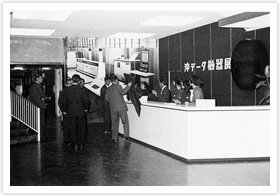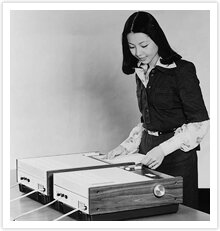part 11
Part 11: Revision of the Public Telecommunications Law and Development of Thermal-type Facsimiles
In 1972, with the goal of promoting the rapid diffusion and development of facsimile machines, the revised Public Telecommunications Law opened telecommunications lines, allowing ordinary companies to connect terminal units. That November, OKI displayed a thermal-type printer in the OKI Data Communications Equipment Exhibit, attracting the attention of the Technology Department of Nikkei Inc., which asked OKI to develop a facsimile machine based on the same technologies. This served as OKI's springboard into the business facsimile machine market.
History of facsimile machines
The history of facsimile is long. The original concept of the facsimile was conceived by a Scottish man, Alexander Bain, in 1843, five years after Morse invented the telegraph and more than 30 years before Bell invented the telephone.
The facsimile machine is reported to have been used for the first time in Japan in 1928 to transmit-from Kyoto to a newspaper publisher in Tokyo-a photo of Emperor Showa's accession ceremony. From that point forward, use of facsimile machines that communicated through dedicated lines expanded for various business applications, including the transmission of photos by newspaper publishers, communicating commands by the police and railway companies, and telegram delivery and collection.
In 1932, OKI founder Kibataro Oki developed a prototype of a simple teletype machine. (In later years, this was to serve as the basis for printer technologies.) From that time, OKI gathered expertise and know-how in printer technologies (printheads) essential to the development of facsimile machines.
In 1972, a revision of the Public Telecommunications Law opened telecommunications lines to terminals, giving ordinary companies access to facsimile machines. Without Internet or electronic mail, communications were generally limited to postal mail and the telephone. Using paper that could be filed as records, the facsimile machine offered instant transmission and guaranteed accuracy, arming ordinary companies with a revolutionary means of communication.
Development of thermal-type facsimile machine

In November 1972, the year in which the Public Telecommunications Law was revised, OKI introduced a new printer technology at the OKI Data Communications Equipment Exhibit. This technology eventually became the global standard for facsimiles. The thermal-type printer on display produced a printed image by selectively heating paper coated with a coloring dye and reagent. The printhead, with an array of heating elements on a small substrate, made contact with the paper to create text and images. OKI's new product attracted a lot of attention from various quarters. The Technology Department at Nikkei Inc. in particular showed keen interest in the unique printhead, which combined mechanical and electronic technologies. Nikkei asked OKI to develop a thermal-type facsimile machine.
Compared to other types of facsimile machines, the thermal type offered numerous advantages: (1) operating costs were low; the cost of journal paper was one-third to one-quarter of that used in electrostatic systems; (2) the technology had low maintenance requirements and required no special operations, aside from paper changing: (3) the printing mechanism was simple; the equipment was compact and light; and the price was reasonable; (4) the device generated relatively little acoustic noise, no electric noise, and no pollution.
Nevertheless, a facsimile machine was useless without a counterparty equipped with another facsimile machine. Cutting product prices and operating costs was key to promoting widespread use of facsimile machines.
OKIFAX 7100 takes the facsimile machine market by storm
Nikkei's request prompted OKI to launch full-fledged development of facsimile machines. In October 1973, OKI delivered its first facsimile machine to Nikkei Inc. Thereafter, OKI began developing telephone/fax machines capable of communicating across general telephone circuits. In September 1974, it announced the analog OKIFAX 600.

system worldwide
The digital OKIFAX 7100 announced in May 1976 solidified OKI's position at the head of the competition for thermal-type facsimile machines. In the early years, the thermal type had drawbacks in terms of speed and resolution (image quality). Armed with pioneering technologies borrowed from thermal printers, OKI's engineering team continued to pursue faster speeds and higher image quality, as well as lower cost. The team not only succeeded in achieving high transmission speeds that cut transmission times to one-sixth that required by the previous model, it streamlined production processes by packaging main parts into modules, achieving dramatic reductions in product costs.
As a result, despite being a latecomer, OKI captured a large market share of the Japanese facsimile machine market, where some 20 companies, including communications equipment manufacturers, office equipment manufactures, and home appliance manufactures, competed fiercely. The advantages of OKI's thermal-type facsimile products-ease of use and low operating costs-allowed OKI to expand sales channels to private companies as well as public offices. One customer, Ina Ceramics Co., Ltd. (now LIXIL Corporation), constructed a nationwide network based on the OKIFAX 7100. When Ina Ceramics used the telephone to send and receive orders to and from branch offices and distributors to inquire about delivery dates and inventory, it faced various issues, including human error and busy telephone lines, particularly as deadlines approached. By installing the OKIFAX 7100, Ina Ceramics achieved dramatic improvements in the speed and accuracy of information transmission.
The thermal type became the mainstream system, accumulating a good track record. In those years, communication between facsimile machines using different systems was not possible, causing problems for many users. Various international standardization efforts sought to resolve this issue. OKI continued to pursue technological innovations while monitoring these standardization efforts.
